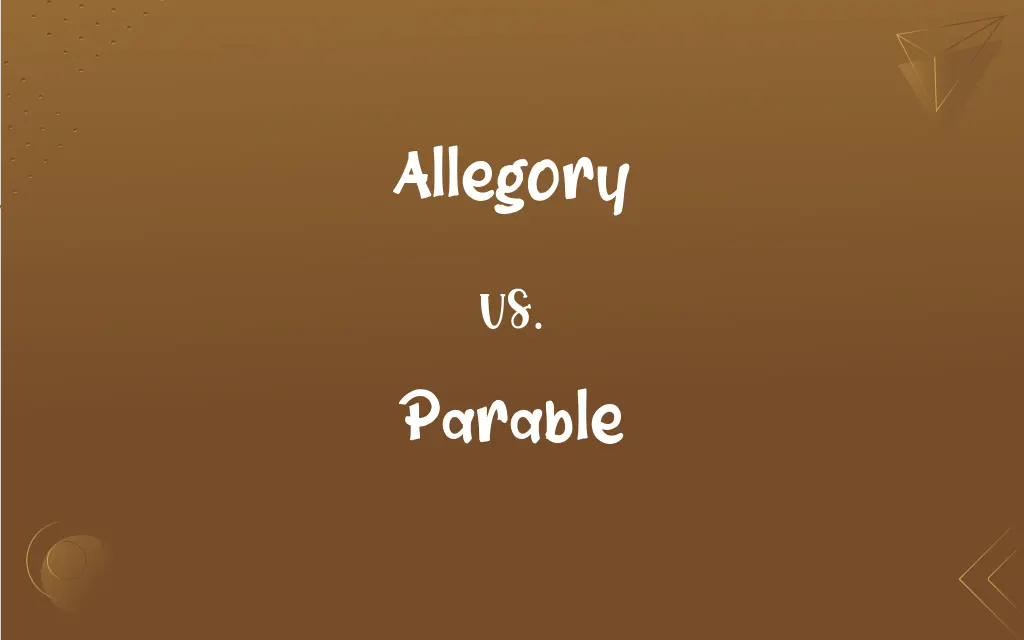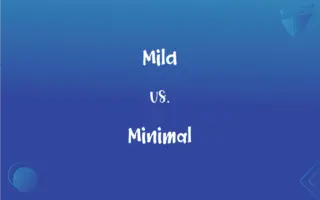Allegory vs. Parable: What's the Difference?
Edited by Harlon Moss || By Janet White || Updated on October 5, 2023
An allegory is a symbolic narrative with a deeper meaning, while a parable is a short, illustrative story teaching a moral lesson.

Key Differences
An allegory is an intricate narrative that uses characters, events, or settings to convey a deeper, often abstract or spiritual, meaning. Allegories often extend throughout the entirety of a story, poem, or visual representation. For instance, a character in an allegory might represent greed or hope. Parables, on the other hand, are succinct tales that highlight a singular moral or spiritual lesson. Their aim is to use the familiar or concrete to shed light on something more abstract.
While both allegories and parables operate on the premise of symbolism, their scope and depth vary. Allegories can be vast and complex, providing layers of interpretation and often requiring more deliberation to unravel their full meanings. On the contrary, parables are designed for immediate impact; they deliver a clear message without extended layers of symbolism.
Think of allegory as a vast mural or tapestry, filled with interconnected symbols forming a coherent but intricate image. In contrast, a parable would be more like a singular, impactful sketch, highlighting one clear lesson or moral. While George Orwell's "Animal Farm" is an allegory of the Russian Revolution, the parable of "The Good Samaritan" teaches the virtue of selfless aid.
It's also worth noting that parables are traditionally associated with religious teachings, especially in the context of the Bible. Jesus, for instance, frequently employed parables to communicate complex spiritual truths in an accessible manner. Allegories, however, are more widely spread across different literary and artistic domains, from John Bunyan's "Pilgrim's Progress" to Plato's allegory of the cave.
Comparison Chart
Definition
A symbolic narrative with deeper meanings.
A short story illustrating a moral lesson.
ADVERTISEMENT
Scope
Extensive, often throughout a story.
Specific, focused on a singular lesson.
Length
Can be lengthy.
Typically short.
Usage
Found in various literature and art.
Often associated with religious teachings.
Interpretation
Requires deeper contemplation to decipher.
Designed for immediate understanding.
Allegory and Parable Definitions
Allegory
A metaphor extended throughout a literary work.
The play served as an allegory for political corruption.
ADVERTISEMENT
Parable
A tale showcasing a practical or ethical principle.
She remembered the parable about reaping what you sow.
Allegory
An intricate narrative with layered meanings.
The allegory painted a picture of society's flaws.
Parable
A story used to explain a doctrine or principle.
The parable taught the villagers to value honesty.
Allegory
Characters or events representing ideas or principles.
In the allegory, the river symbolized life's journey.
Parable
A simple narrative illustrating a spiritual truth.
The parable of the prodigal son speaks of forgiveness.
Allegory
Artistic expression using symbols to convey abstract ideas.
The film was an allegory of the human psyche.
Parable
A brief story teaching a moral lesson.
The parable emphasized the importance of kindness.
Allegory
The representation of abstract ideas or principles by characters, figures, or events in narrative, dramatic, or pictorial form.
Parable
An illustrative narrative conveying wisdom.
He shared a parable about the consequences of envy.
Allegory
A story, picture, or play employing such representation. John Bunyan's Pilgrim's Progress and Herman Melville's Moby-Dick are allegories.
Parable
A simple story illustrating a moral or religious lesson.
Allegory
A symbolic representation
The blindfolded figure with scales is an allegory of justice.
Parable
A short narrative illustrating a lesson (usually religious/moral) by comparison or analogy.
In the New Testament the parables told by Jesus Christ convey His message, as in "The parable of the prodigal son".
Catholic sermons normally draw on at least one Biblical lecture, often parables.
Allegory
(rhetoric) A narrative in which a character, place, or event is used to deliver a broader message about real-world issues and occurrences.
Parable
(transitive) To represent by parable.
Allegory
A picture, book, or other form of communication using such representation.
Parable
(obsolete) That can easily be prepared or procured; obtainable.
Allegory
A symbolic representation which can be interpreted to reveal a hidden meaning, usually a moral or political one.
Parable
Procurable.
Allegory
A category that retains some of the structure of the category of binary relations between sets, representing a high-level generalisation of that category.
Parable
A comparison; a similitude; specifically, a short fictitious narrative of something which might really occur in life or nature, by means of which a moral is drawn; as, the parables of Christ.
Declare unto us the parable of the tares.
Allegory
A figurative sentence or discourse, in which the principal subject is described by another subject resembling it in its properties and circumstances. The real subject is thus kept out of view, and we are left to collect the intentions of the writer or speaker by the resemblance of the secondary to the primary subject.
Parable
To represent by parable.
Which by the ancient sages was thus parabled.
Allegory
Anything which represents by suggestive resemblance; an emblem.
Parable
A short moral story (often with animal characters)
Allegory
A figure representation which has a meaning beyond notion directly conveyed by the object painted or sculptured.
Parable
(New Testament) any of the stories told by Jesus to convey his religious message;
The parable of the prodigal son
Allegory
A short moral story (often with animal characters)
Allegory
A visible symbol representing an abstract idea
Allegory
An expressive style that uses fictional characters and events to describe some subject by suggestive resemblances; an extended metaphor
Allegory
A story or representation that symbolizes a broader concept.
The novel was an allegory for the struggle of good and evil.
FAQs
What's the primary purpose of an allegory?
To convey deeper, symbolic meanings throughout a narrative.
Are parables always religious?
While often associated with religion, parables can be secular too.
Do allegories always need interpretation?
Often, yes, as they contain layered meanings.
Can films be allegorical?
Absolutely, many films have allegorical elements.
Can a whole novel be an allegory?
Yes, many novels, like "Animal Farm", are allegorical.
What's a key characteristic of a parable?
It's a short story teaching a clear moral lesson.
Who commonly used parables in teachings?
Jesus Christ frequently used parables in his teachings.
Is a parable always fictional?
Typically, yes, as it's a tool to illustrate a lesson.
Can songs contain allegories?
Yes, some songs use allegory to convey deeper messages.
Why are parables effective in teachings?
Their simplicity and relatability make complex truths accessible.
About Author
Written by
Janet WhiteJanet White has been an esteemed writer and blogger for Difference Wiki. Holding a Master's degree in Science and Medical Journalism from the prestigious Boston University, she has consistently demonstrated her expertise and passion for her field. When she's not immersed in her work, Janet relishes her time exercising, delving into a good book, and cherishing moments with friends and family.
Edited by
Harlon MossHarlon is a seasoned quality moderator and accomplished content writer for Difference Wiki. An alumnus of the prestigious University of California, he earned his degree in Computer Science. Leveraging his academic background, Harlon brings a meticulous and informed perspective to his work, ensuring content accuracy and excellence.
































































